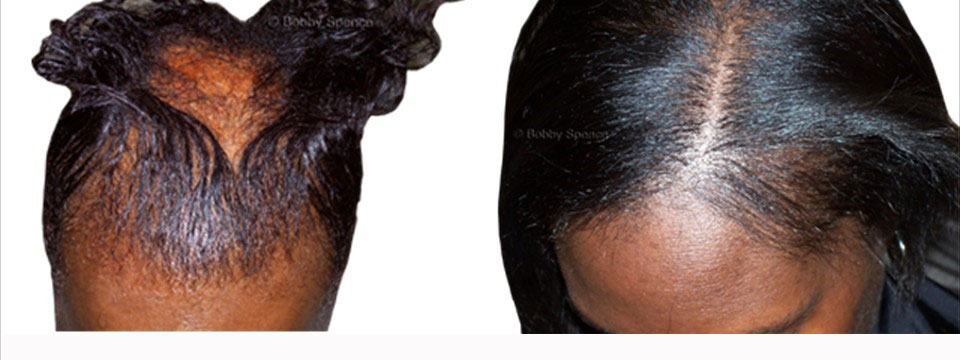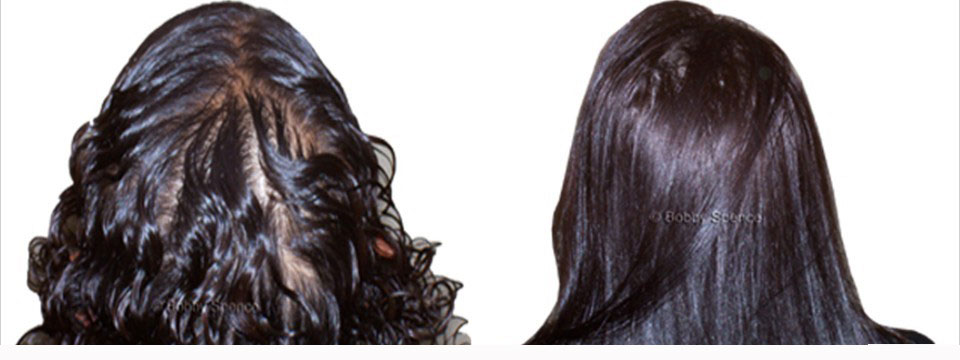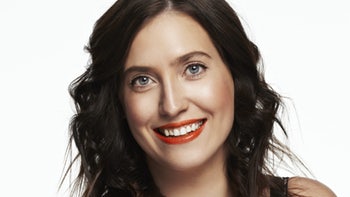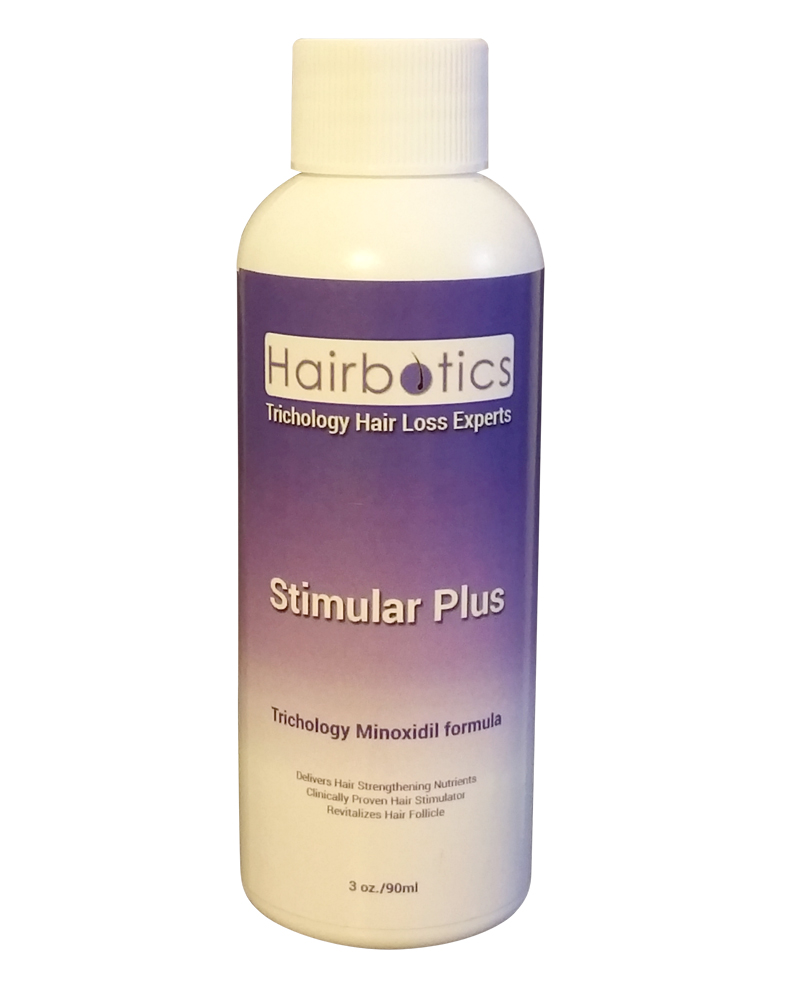Female Hair Loss
There are over 30 Million women suffering from hair loss. There are many reasons for this widespread incidence. Although most of these women will never completely lose all their hair, they will experience diffuse hair loss (thinning) of the entire scalp. It is estimated that most women lose up to 50% of their hair before they notice the hair loss.

Hair is considered a woman’s “Crown of Glory” and is associated with her beauty. Hair loss in women can be devastating as if affects their self-esteem, confidence, work ethic, and can cause undo stress on the body.
The term Male Pattern Baldness (MPB) tends to lay credence to the thought that hair loss is primarily a male problem. While males do lose hair more readily and tend to lose hair in sections, women suffer baldness and hair thinning also, except the thinning is more uniform throughout the head. With this is mind, women are better candidates for surgical hair replacement and weaving treatments, because large portions of the scalp are highly unlikely to be bald on a woman suffering with androgenetic alopecia.
Because a great deal more emphasis is put on the beauty of a woman’s hair, this is becoming a great concern for today’s woman. While the general information covered thus far is good for all persons in general, there are a few things specific to women concerning hair loss.

Many women suffer hair loss and an increase of facial hair after the onset of menopause. This is because of the drop in estrogen production, changing the ratio of estrogen to testosterone in a woman’s body. Prior to menopause, a woman’s body is constantly producing estrogen, which binds excess testosterone to proteins called globulins. Therefore, there is little excess testosterone in a woman’s body. After the onset of menopause this estrogen is no longer present, thereby exposing it to a similar although milder type of syndrome that males go through concerning the overproduction of DHT. An interesting note is that once again, the syndrome of menopause and its unique effects are not as common in the Eastern world, but are specific to Western civilization. The key differences are the consumption of less red meat and fatty foods in Eastern lands than in the West and less daily stressors in most Eastern lands as compared to Western civilization.

Anorexia is an eating disorder that is becoming more prevalent among women in the past few decades and is psychologically driven in Western society due to the emphasis put on slender women being the ideal in Western civilization. Needless to say, if you or a loved one is suffering with this disorder, a qualified physician should treat any cases of anorexia. However, some of the side effects of anorexia can be hair loss due to the malnutrition the syndrome caused. In this case, it is vital to carefully follow the advice given in the sections Nutrition, Diet, and Hair Loss, and Natural Hair Remedies.
It is of course recommended in all cases that you reduce your intake of red meats, fatty foods, and reduce stress, however due to your profession and engrained habits there may be a limit to how much you can change this part of your lifestyle. There is another factor in Eastern civilizations that may cause a stark difference in their women not suffering through typical menopausal symptoms here in the West. The consumption of soybeans and soybean products is much higher in the East. This is significant because soy contains estrogen-like substances and work in the body similarly to estrogen. Therefore there is not an extreme drop in estrogen levels in women who consume soybean products, thus reducing the symptoms of menopause typically suffered in the West.
Some women who suffer hair loss tend to have gastrointestinal problems that do not allow them to absorb proteins and zinc that are necessary to maintain a healthy head of hair. If you think that you have problems with your gastrointestinal system and are experiencing unusual hair loss, of course see your doctor. You may be able to take some natural non-dairy acidophilus after meals for a couple of months in order to increase your digestion of these nutrients.
There are a number of myths associated with hair loss in women particularly. Many were told that brushing the hair 100 strokes each night will promote healthy hair growth. As mentioned earlier, extreme brushing of the hair can cause stress on the hair which can cause breakage and hair loss. Also, just as hats have been rumored to cause hair loss, wearing wigs has also been rumored to cause hair loss. This is very untrue, especially if the scalp is given sufficient time to breathe at night and hair is washed regularly to avoid buildup. Although stress can cause temporary hair loss, permanent hair loss is usually unconnected to stress. Last but not least, the belief that there are cosmetic products that are out on the market that grow hair is simply unfounded. There is only one product on the market that has been proven to grow hair on women safely, and that is minoxidil.
Click here to order Minoxidil
During pregnancy hair growth increases dramatically in most women. This increases the usual percentage of hair normally growing on the head. Therefore, after childbirth there may be an increase in hair loss due to more hair follicles than usual entering the rest phase. The temporary excessive loss of hair usually occurs between one and three months after childbirth and is quite normal; it should balance out a few months after childbirth at most. Similar syndromes occur after ceasing birth control pills or switching types of birth control pills.
- Top 7 Causes of Female Hair Loss
1. Hair Loss caused by Hormones. Androgentic alopeica (hereditary hair loss) is the number one cause of female pattern hair loss. It accounts for a slow decline in scalp hair density. When testosterone coverts into DHT it has a miniaturizing effect on the hair follicle which leads to thinning and ultimately hair loss. Also low levels of estrogen and progesterone can be the culprit.
2. Hair Loss caused by Vitamin Deficiency. Low Ferritin (iron storage)and Vitamin D are closely linked to hair shedding and hair breakage. When iron is low the hair loses elasticity becomes dry and brittle and constantly breaks off. Lose anagen syndrome can also occur if the connective tissue of the hair bulb is weak.
3. Hair Loss caused by stress. Unless you are pulling your hair out from stress (trichotillomania), then the female hormone cortisol can elevate and cause antigens to attack the scalp and cause hair loss. Also stress can worsen autoimmune diseases by affecting the hypothalamus and pituitary gland which will secrete hormones that promote inflammation.
4. Hair Loss caused by birth control. Some birth control pills, IUD’s can shock the body and cause hormonal imbalances that can trigger diffuse hair loss (telogen effluvium) which causes hairs to pass prematurely to the telogen stage. During the stage of hair growth we normally lose between 50-100 hairs however, due to the sudden shock you will experience excessive hair shedding which you will see in your brush or bathroom floor. This is type of hair loss is normally temporary and self correcting but in some cases you should consult your doctor and possibly lower your dosage or switch altogether.
5. Hair Loss caused by medications. Check with your doctor to see if your medication contraindicates hair loss. The body normally can quickly recover once adjusted to medications however in some cases it will continue for as long as you take it.
6. Auto-immune conditions. Condtions such as diabetes, hypothyroidism, rheumatoid arthritis, intestinal cystitis and fibromyalgia, celiac disease, and lupus.
7. Hair Loss caused by chemical damage. Over processing of the hair due to hair color, relaxers, perms, highlights will cause hair breakage (Trichorrhexis Nodosa) and will cause the hair cuticle to become frayed and leak proteins. Split ends (trichoptilosis) will also occur.
- 8 Foods To Eat For Naturally Shinier, Healthier Hair (Ft. Bobby Spence)

By Julia Teen @JuliaTeen
It’s pretty well drilled into us now what we need to do to achieve great hair: lay off the hot tools, change up your hairstyle every day so you’re not causing damage in the same places constantly, never send a brush through wet hair, and feed your strands weekly with a rich moisturizing masque.
But what happens if you follow these rules religiously and are still finding that you can’t grow your hair past your collarbone without it breaking off? What if it’s a sea of split ends or just generally a thin, fragile mess? Just like diet can play a role in improving your skin, what you eat is an important part of your haircare routine, too.
Why Does It Matter?
Would it be best to reword this to: “When we indulge in an unhealthy diet with limited nutrients, our body uses these for the more vital organs in the body – since the body technically doesn’t require hair to function, it limits the supply”
“Hair is the fastest growing tissue in the human body,” says trichologist — that’s a hair and scalp specialist — Bobby Spence. “When we indulge in an unhealthy diet with limited nutrients, our body uses those few nutrients for the more vital organs in the body. Since the body technically doesn’t require hair to function,” it misses out, which results in thinning, breakage and split ends.
Luckily, our hair works on a three part growth cycle: the anagen (growth) phase, catagen (transitional, or shedding) phase, and telogen (resting) phase. Eighty-five percent of your hair is always in the growing phase, and 15 percent is in the shedding phase, which lasts about five to six weeks, says Spence. “When we eat unhealthily, the hair stays in the shedding phase for an extended period. We need to eat better to help strengthen strands and restore the hair back into the growth phase.” Depending on what phase your hair is in, it can take anywhere from three weeks to six months to see healthy improvements.
So it’s not a quick fix sitch. But diet overall never is, right?
What Should You Eat for Healthier Hair?
Here are Spence’s top foods for kicking your system into hair growth renewal.
Eggs: “Our hair is a protein called keratin, which is made up of 18 amino acids,” he explains. “Eggs contain 9 of these amino acids and supply your hair with any that you are lacking.”
Salmon: “Wild caught salon is loaded with amino acids, omega-3s, and protein, which makes it an excellent food for healthy hair,” he says, adding, “Omega-3 fatty acids act as a lubricant for dry, brittle hair.”
Kale: “Kale is very high in iron and vitamin C, which helps to absorb iron. Iron assists in carrying oxygen to the hair and determines the elasticity of hair. It also revs up the growth cycle of your hair.”
LA-based trichologist Kari Williams suggests loading up on the following foods, as well, to restart your hair growth cycle. She’s all about protein, protein, protein:
Tuna and Beans: “They all have a high protein content. Since hair is made up of mostly protein, it needs it to grow.”
Spinach (or other dark, leafy greens): “It’s got a high iron count and is packed with vitamin E, which protects the hair from free radical damage.” Your hair can age, too, which is why antioxidants like vitamin E are so important.
Lean Meats: “They’re a good source of iron. Deficiency in iron can lead to hair loss, so it’s important to have a regular source of it in your body.” Lean meats include beef, turkey breast, skinless chicken and pork.
Walnuts: “Like salmon, walnuts are rich in omega-3 fatty acids that your body can’t produce, but are essential to hair growth and keeping your scalp healthy.”
What Else Can Be Done?
We get told to take hair supplements like Biotin and Viviscal all the time, but this shouldn’t replace a whole food diet. “The best way to get the nutrients your hair needs is through a well-balanced diet,” says Williams. “Taking additional nutritional supplements only helps get nutrients you may not get enough of even from a healthy diet.”
Spence agrees that diet has to come first and foremost. Supplements, he says, aren’t designed to be your main source of nutrients, mainly because they don’t work as well. “Most supplements come from synthetic sources as opposed to whole food sources, so they don’t absorb as well in the body.”
Hairbotics Stimular Plus Trichology Minoxidil

formulated by Trichologist Bobby Spence
NEW 4-1 FORMULA
- Stimulates Hair Regrowth
- Clinical Strength formulation
- Revitalizes hair follicles and stimulates hair regrowth
- Inhibits DHT levels
- Reduces Gray Hair in new and current growth
- Designed for women and men
- No Scalp irritation, burning, or flaking
- 1 bottle – 2 month supply (90ml)
- Minoxidil is the only FDA approved ingredient for hair regrowth
- Best non-surgical treatment for hair loss
- For all hair types and textures
